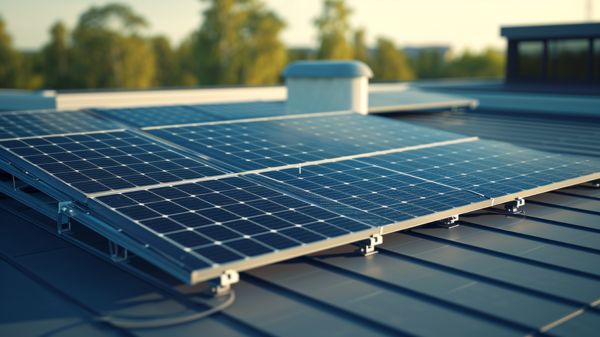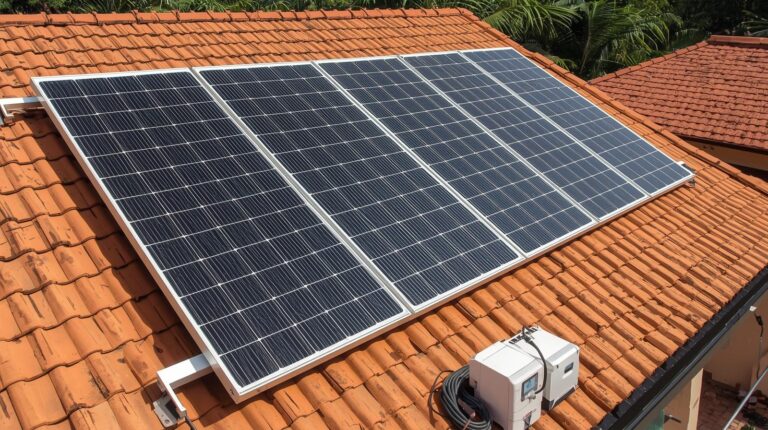In the domain of renewable energy, the quest for enhanced efficiency in photovoltaic cells continues to drive technological innovation. In this article we’ll be discussing some of the latest best materials for photovoltaic cell efficiency you need to know.
Recent breakthroughs have centered on materials such as multi-junction solar cells, which capitalize on layered semiconductors to capture a wider spectrum of sunlight, and perovskite solar cells, known for their cost-effectiveness and superior light absorption properties.
As researchers also explore the potential of Gallium Arsenide and emerging quantum dot technologies, these materials collectively signal a transformative shift in solar energy applications. Such advancements raise pivotal questions about the future landscape of solar technology—how will these materials integrate into existing systems, and what are the implications for global energy sustainability?
Multi-Junction Solar Cells
Multi-junction solar cells (MJ cells) represent a significant advancement in photovoltaic technology, achieving efficiencies exceeding 46% under concentrated sunlight by utilizing multiple semiconductor layers to capture a broader spectrum of solar energy.
These cells excel in energy conversion by employing stacked layers of semiconductor materials, each tailored to absorb different segments of the solar spectrum. This architecture enables MJ cells to surpass the fundamental efficiency limits of traditional single-junction cells, which cap at 33.16%.
The design of multi-junction solar cells includes a meticulous selection of semiconductor materials with varying bandgaps. For instance, the ideal bandgaps for a dual-junction setup are around 0.77 eV and 1.70 eV. This strategic selection allows for the efficient harvesting of photons across a wide range of wavelengths, thereby maximizing the energy conversion process.
Additionally, advanced configurations like triple-junction cells integrate materials such as InGaP, GaAs, and InGaAs on germanium substrates, pushing efficiencies close to 40% under similar conditions.
Enhancements such as low-resistivity metallic contacts, anti-reflective coatings, and tunnel junctions further refine the performance of MJ cells. These technological integrations are critical in minimizing energy losses and refining charge carrier dynamics within the cells, steering them closer to their theoretical maximum efficiency limit of 86.8%.
Perovskite Material Innovations
Perovskite solar cells, recognized for their high efficiency rates, are now being refined to address their stability issues which previously limited their commercial viability.
Innovations in the engineering of perovskite materials aim to extend the operational lifespan of these cells, which is critical for their application in real-world environments.
Furthermore, the low-temperature processing requirements of perovskite cells present an opportunity for more cost-effective production methods, potentially lowering the barriers to their widespread adoption in the photovoltaic market.
Perovskite Stability Enhancements
Recent advancements have notably enhanced the stability of perovskite solar cells, some of which now boast lifetimes measured in years—a marked improvement over the months of stability previously observed.
Key to these advancements is the strategic use of additives that reinforce the perovskite layers’ robustness without impairing their bandgap. This careful balancing act preserves the cells’ high efficiency while greatly extending their operational lifespan.
Furthermore, the optimization of the electron transport layer plays a pivotal role. Researchers have found that incorporating tin dioxide not only facilitates more effective charge carrier pathways but also contributes to greater overall stability and enhanced cell performance. This approach addresses the dual objectives of maintaining efficiency and prolonging durability, which are critical for the practical application of perovskite solar cells.
Additionally, innovative processing techniques like chemical bath deposition are being employed to produce perovskite films that are more resistant to environmental degradation. These methods guarantee a uniform and stable layer formation, which is essential for sustaining performance over time.
Through such collaborative and detailed research efforts, the path towards achieving both high efficiency and long-term stability in perovskite solar cells continues to clear, promising a brighter future for solar technology.
Cost-Effective Production Methods
Building on the significant strides made in enhancing perovskite stability, attention is now shifting towards refining production processes to make these advancements economically viable.
Perovskite materials, known for their potential in achieving superior conversion efficiency in photovoltaic cells, are now seeing innovations aimed at scaling production while reducing costs.
The ability to process these materials at temperatures below 200°C presents a substantial cost advantage over traditional high-temperature silicon cell production, impacting overall energy consumption and cost.
Recent advancements in chemical bath deposition methods have streamlined the formation of perovskite layers. This technique not only guarantees uniform layer quality essential for high conversion efficiency but also aligns with cost-effective production methods by optimizing the use of precursor solutions.
The result is a scalable approach to manufacturing photovoltaic cells that does not sacrifice performance for cost. The table below illustrates key aspects of perovskite production enhancements:
| Feature | Impact |
|---|---|
| Low-temperature processing | Reduces energy costs |
| Thin-layer technology | Lowers transport and installation costs |
| Chemical bath deposition | Optimizes production scalability |
| >25% conversion efficiency | Competes with silicon-based cells |
| Stability focus | Maintains cost without compromising performance |
These innovations represent a pivotal shift towards making perovskite-based photovoltaic technology a practical alternative in the renewable energy landscape.
Gallium Arsenide Enhancements
Turning now to Gallium Arsenide (GaAs) enhancements in photovoltaic cells, significant advancements have been noted in the efficiency gains, structural innovations, and the broader market impact of these cells.
The integration of GaAs in multi-junction cells has pushed efficiency boundaries beyond the theoretical limits of single-junction cells, achieving remarkable results under concentrated sunlight.
Furthermore, innovations in the structural design of GaAs cells are facilitating their adoption in specialized sectors, prompting a detailed analysis of their evolving role in the market.
GaAs Efficiency Gains
Gallium arsenide (GaAs) solar cells, recognized for their superior efficiency, have achieved laboratory conversion rates exceeding 30%, with ongoing enhancements promising further improvements.
As a pivotal material in the photovoltaic domain, GaAs is instrumental in advancing solar energy technology. Its direct bandgap of approximately 1.42 eV optimizes the conversion of sunlight into electricity, making it an ideal candidate for high-efficiency photovoltaic applications.
GaAs cells excel not only in terrestrial settings but also in extraterrestrial environments, boasting exceptional radiation resistance. This characteristic is particularly valuable for space applications, where traditional solar cell materials often falter under cosmic ray exposure. Additionally, the lower temperature coefficient of GaAs enhances its performance in climates where high temperatures might otherwise diminish the efficiency of other photovoltaic materials.
Incorporating GaAs into multi-junction solar cells has further expanded its utility. These cells, designed to absorb a broader spectrum of sunlight, now achieve around 40% efficiency under concentrated sunlight conditions. This substantial gain is a demonstration of GaAs’s ability to liberate solar energy potential, underscoring its role in the ongoing quest for more efficient renewable energy solutions.
Structural Innovations
Furthering the advancements in GaAs solar cells, structural innovations play a pivotal role in pushing the boundaries of photovoltaic efficiency. Gallium arsenide, with its ideal bandgap of approximately 1.43 eV, excels in capturing a broad spectrum of solar energy, consequently surpassing traditional silicon-based cells in efficiency metrics.
The integration of multi-junction configurations is a notable structural innovation in this domain. These configurations layer multiple GaAs cells, each tailored with distinct bandgaps to absorb different light wavelengths effectively. This stratagem greatly boosts the conversion efficiency by harnessing a wider spectrum of solar radiation.
Moreover, the adoption of tunnel junctions within these multi-junction cells marks a critical engineering enhancement. These junctions mitigate electrical resistance between the layers, facilitating smoother current flow and superior energy capture. This advancement enables GaAs cells to achieve efficiencies over 46% under concentrated solar conditions.
Additionally, the resilience of GaAs cells against temperature fluctuations enhances their viability for extreme environmental applications, including aerospace and concentrated photovoltaics.
The evolution of substrate technologies also contributes extensively to structural innovations. Lightweight and flexible GaAs materials are revolutionizing the deployment of solar technologies, extending their application from advanced space missions to everyday portable electronics.
These structural innovations collectively catalyze the liberation and expansion of energy solutions, propelling GaAs solar cells to the forefront of photovoltaic technology.
Market Impact Analysis
Analyzing the market impact of gallium arsenide enhancements reveals a nuanced landscape dominated by high-efficiency potentials offset by cost-related challenges.
Gallium arsenide (GaAs) cells, with laboratory efficiencies exceeding 29%, stand at the pinnacle of photovoltaic technology, particularly for concentrated sunlight applications. The unique attribute of GaAs cells lies in their ideal bandgap of approximately 1.42 eV, enabling superior energy conversion across a broader spectrum.
This characteristic not only amplifies their efficacy in terrestrial solar power systems but also underscores their preeminence in space applications where efficiency and weight are paramount.
However, the broader adoption of GaAs technology in commercial markets remains stymied by its high production costs compared to traditional silicon cells. Despite this, ongoing advancements in epitaxial growth techniques present a promising avenue for cost reduction and performance enhancement. Such innovations are pivotal for GaAs cells to secure a larger market share in the renewable energy sector.
The future market trajectory for GaAs enhancements in solar power hinges on balancing these cost-efficiency equations. As manufacturing processes evolve and become more economical, GaAs cells are poised to play a transformative role in meeting global energy needs with unprecedented efficiency levels, heralding a new era of energy liberation.
Silicon-Tandem Cell Developments
Silicon-tandem solar cells, which incorporate a perovskite layer atop traditional silicon structures, have reached efficiencies up to 32.5%, outperforming standard panels by a considerable margin.
This innovative approach leverages the complementary properties of both materials, where silicon’s robust performance under lower light conditions harmonizes with perovskite’s exceptional efficiency under direct sunlight.
By effectively splitting the solar spectrum, these cells maximize the conversion of solar radiation into electrical energy, pushing the boundaries of photovoltaic technology.
The architectural integration within silicon-tandem cells allows for more effective utilization of the light spectrum.
This optimized division enhances the overall energy output and considerably boosts the efficiency of solar energy systems.
Pioneering companies like Qcells are at the forefront of refining these technologies, focusing on overcoming the technical and economic challenges associated with tandem cell production.
Their research aims to enhance the scalability and cost-effectiveness of these high-efficiency photovoltaic solutions.
Organic Photovoltaic Compounds
Organic photovoltaic (OPV) compounds represent a transformative development in solar technology, utilizing carbon-based materials to facilitate the creation of low-cost, flexible solar cells.
These OPVs have seen significant enhancements, with recent breakthroughs pushing efficiencies beyond 18%, nearing a promising threshold of 20%. Such advancements are pivotal in the deployment of OPVs across various photovoltaic applications, offering a viable alternative to traditional silicon-based technologies.
The appeal of OPVs lies not only in their economic and environmental benefits but also in their physical attributes. These compounds enable the production of lightweight, semi-transparent cells that integrate seamlessly into building facades and mobile devices, promoting energy liberation in urban and remote settings alike. Additionally, their efficacy under low-light conditions boosts energy yield in less-than-ideal weather, enhancing their practicality and user autonomy.
Central to these developments are non-fullerene acceptors, which have revolutionized organic photovoltaic systems by offering improved stability and efficiency. The shift from traditional fullerene-based materials to these novel acceptors mitigates environmental concerns and propels OPVs towards a more sustainable future in energy generation, aligning with a global push towards minimizing carbon footprints and enhancing energy security.
Light Concentrating Technologies
Light concentrating technologies, such as concentrator photovoltaics (CPV), employ optics like lenses or mirrors to focus and intensify sunlight onto high-efficiency multi-junction solar cells.
This method considerably boosts the efficiency of these cells, achieving power conversion efficiencies up to 40% under concentrated sunlight, far surpassing the performance of traditional photovoltaic systems. By focusing light, these technologies reduce the requisite amount of expensive photovoltaic material, thereby optimizing the cost-effectiveness of solar installations.
The strategic integration of light concentrators with multi-junction solar cells not only enhances efficiency but also addresses the inherent limitations of single-junction photovoltaic technologies, which are bound by a maximum efficiency of about 33%.
Concentrator photovoltaic systems are particularly advantageous in regions with abundant direct sunlight, where they have demonstrated efficiencies exceeding 46% in controlled environments. These systems incorporate sophisticated tracking mechanisms and optical components to maximize exposure to sunlight, thereby optimizing energy collection throughout the day.
This approach represents a considerable step forward in photovoltaic technology, offering a viable solution to increasing the liberation and accessibility of solar energy by improving the efficiency and reducing the material costs of solar power systems.
Quantum Dot Solar Cells
Quantum dot solar cells, characterized by their utilization of nanoscale semiconductor particles, represent a considerable advancement in photovoltaic technology due to their enhanced light absorption capabilities and potential for high efficiency.
These cells remarkably utilize quantum dots that can be precisely engineered to optimize their bandgap, thereby maximizing the absorption of both visible and infrared light spectrums. This tunability enhances the power conversion efficiencies of these cells, which currently surpass 16% and are projected to reach up to 50% with further development in quantum dot configurations and hybrid system integrations.
A pivotal aspect of quantum dot solar cells is their ability to support multiple exciton generation (MEG). This advanced phenomenon allows a single photon absorbed by a quantum dot to generate multiple electron-hole pairs, thereby greatly increasing the efficiency of energy conversion. The potential of MEG in these solar cells could revolutionize energy capture efficiency, making quantum dot solar cells a cornerstone for future photovoltaic innovations.
Moreover, their lightweight and flexible properties render quantum dot solar cells ideal for diverse applications, ranging from portable electronics to building-integrated photovoltaics. This versatility, alongside their superior light absorption capabilities and escalating power conversion efficiencies, underscores their transformative potential in solar technology.
Conclusion
In summary, the evolution of photovoltaic materials, including multi-junction, perovskite, and gallium arsenide cells, alongside emerging technologies like silicon-tandem, organic compounds, and quantum dot solar cells, represents a significant leap in solar energy efficiency.
These advancements not only enhance the spectrum of sunlight conversion but also promise cost-effective and adaptable solutions for energy demands globally.
Continued research and development in these domains are essential for achieving sustainable energy goals and mitigating climate change impacts.




